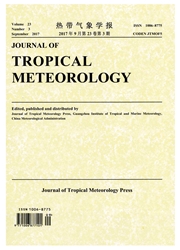

 中文摘要:
中文摘要:
Based on an analysis of the relationship between the tropical cyclone genesis frequency and large-scale circulation anomaly in NCEP reanalysis, large-scale atmosphere circulation information forecast by the JAMSTEC SINTEX-F coupled model is used to build a statistical model to predict the cyclogenesis frequency over the South China Sea and the western North Pacific. The SINTEX-F coupled model has relatively good prediction skill for some circulation features associated with the cyclogenesis frequency including sea level pressure, wind vertical shear, Intertropical Convergence Zone and cross-equatorial air flows. Predictors derived from these large-scale circulations have good relationships with the cyclogenesis frequency over the South China Sea and the western North Pacific. A multivariate linear regression(MLR) model is further designed using these predictors. This model shows good prediction skill with the anomaly correlation coefficient reaching, based on the cross validation, 0.71 between the observed and predicted cyclogenesis frequency. However, it also shows relatively large prediction errors in extreme tropical cyclone years(1994 and 1998, for example).
 英文摘要:
英文摘要:
Based on an analysis of the relationship between the tropical cyclone genesis frequency and large-scale circulation anomaly in NCEP reanalysis, large-scale atmosphere circulation information forecast by the JAMSTEC SINTEX-F coupled model is used to build a statistical model to predict the cyclogenesis frequency over the South China Sea and the western North Pacific. The SINTEX-F coupled model has relatively good prediction skill for some circulation features associated with the cyclogenesis frequency including sea level pressure, wind vertical shear, Intertropical Convergence Zone and cross-equatorial air flows. Predictors derived from these large-scale circulations have good relationships with the cyclogenesis frequency over the South China Sea and the western North Pacific. A multivariate linear regression (MLR) model is further designed using these predictors. This model shows good prediction skill with the anomaly correlation coefficient reaching, based on the cross validation, 0.71 between the observed and predicted cyclogenesis frequency. However, it also shows relatively large prediction errors in extreme tropical cyclone years (1994 and 1998, for example).
 同期刊论文项目
同期刊论文项目
 同项目期刊论文
同项目期刊论文
 期刊信息
期刊信息
